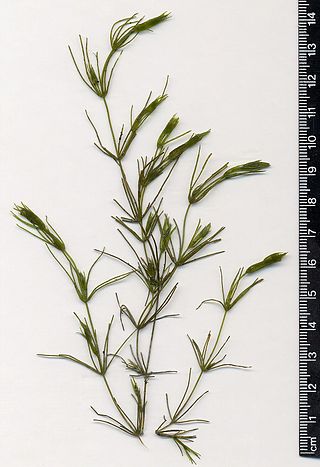
Chlamydomonadales, also known as Volvocales, are an order of flagellated or pseudociliated green algae, specifically of the Chlorophyceae. Chlamydomonadales can form planar or spherical colonies. These vary from Gonium up to Volvox. Each cell has two flagella, and is similar in appearance to Chlamydomonas, with the flagella throughout the colony moving in coordination.

Pedinellales is a group of single-celled algae found in both marine environments and freshwater.

The glaucophytes, also known as glaucocystophytes or glaucocystids, are a small group of unicellular algae found in freshwater and moist terrestrial environments, less common today than they were during the Proterozoic. The stated number of species in the group varies from about 14 to 26. Together with the red algae (Rhodophyta) and the green algae plus land plants, they form the Archaeplastida.

Fucus vesiculosus, known by the common names bladderwrack, black tang, rockweed, sea grapes, bladder fucus, sea oak, cut weed, dyers fucus, red fucus and rock wrack, is a seaweed found on the coasts of the North Sea, the western Baltic Sea and the Atlantic and Pacific Oceans. It was the original source of iodine, discovered in 1811, and was used extensively to treat goitre, a swelling of the thyroid gland related to iodine deficiency.

Charales is an order of freshwater green algae in the division Charophyta, class Charophyceae, commonly known as stoneworts. Depending on the treatment of the genus Nitellopsis, living (extant) species are placed into either one family (Characeae) or two. Further families are used for fossil members of the order. Linnaeus established the genus Chara in 1753.

Palmaria palmata, also called dulse, dillisk or dilsk, red dulse, sea lettuce flakes, or creathnach, is a red alga (Rhodophyta) previously referred to as Rhodymenia palmata. It grows on the northern coasts of the Atlantic and Pacific Oceans. It is a well-known snack food. In Iceland, where it is known as söl, it has been an important source of dietary fiber throughout the centuries.

Porphyra is a genus of coldwater seaweeds that grow in cold, shallow seawater. More specifically, it belongs to red algae phylum of laver species, comprising approximately 70 species. It grows in the intertidal zone, typically between the upper intertidal zone and the splash zone in cold waters of temperate oceans. In East Asia, it is used to produce the sea vegetable products nori and gim. There are considered to be 60–70 species of Porphyra worldwide and seven around Britain and Ireland, where it has been traditionally used to produce edible sea vegetables on the Irish Sea coast. The species Porphyra purpurea has one of the largest plastid genomes known, with 251 genes.

AlgaeBase is a global species database of information on all groups of algae, both marine and freshwater, as well as sea-grass.

Guiry-en-Vexin is a commune in the Val-d'Oise department in Île-de-France in northern France.

Chlorokybus is a multicellular (sarcinoid) genus of basal green algae or charophyte. It has been classified as the sole member of the family Chlorokybaceae, which is the sole member of the order Chlorokybales, in turn the sole member of the class Chlorokybophyceae. It grows on soil and rock surfaces, and is rare.

The Nire—Fourmilewater GAA is a Gaelic Athletic Association club based in Ballymacarbry, County Waterford in Ireland. The Nire and Fourmilewater are two separate clubs, with separate committees pulling from the same pool of players. The Nire is the Gaelic football club in the area and Fourmilewater the hurling club. Both teams play in the Mill Field, Ballymacarbry. The Nire is a half parish with Touraneena, while Fourmilewater is a half parish with Newcastle, County Tipperary. The Nire play in yellow and blue, while Fourmilewater play in blue and white. The related Ballymacarby Ladies' Gaelic football club has won 10 All-Ireland Ladies' Club Football Championship titles.

Dictyochophyceae sensu lato is a photosynthetic lineage of heterokont algae.

Prymnesiophyceae is a haptophyte class. Although it was originally described by Casper in 1972, it did not receive a Latin diagnosis until Hibberd provided one in 1976.

Isochrysidales is an order of Haptophyceae.

Bodonida is an order of kinetoplastid flagellate excavates. It contains the genera Bodo and Rhynchomonas, relatives to the parasitic trypanosomes. This order also contains the colonial genus Cephalothamnium.

Cystoseira foeniculacea is a species of brown alga in the genus Cystoseira.

Diatoms belong to a large group called the heterokonts, which include both autotrophs such as golden algae and kelp; and heterotrophs such as water moulds. The classification of heterokonts is still unsettled: they may be designated a division, phylum, kingdom, or something intermediate to those. Consequently, diatoms are ranked anywhere from a class, usually called Diatomophyceae or Bacillariophyceae, to a division (=phylum), usually called Bacillariophyta, with corresponding changes in the ranks of their subgroups.
















